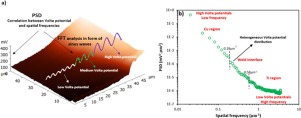当前位置:
X-MOL 学术
›
Corros. Sci.
›
论文详情
Our official English website, www.x-mol.net, welcomes your
feedback! (Note: you will need to create a separate account there.)
Studies correlation of surface Volta potential with galvanic corrosion initiation sites in solid-state welded Ti-Cu bimetal using AFM-SKPFM
Corrosion Science ( IF 7.4 ) Pub Date : 2018-08-01 , DOI: 10.1016/j.corsci.2018.06.026 Ehsan Rahimi , Ali Rafsanjani-Abbasi , Amin Imani , Saman Hosseinpour , Ali Davoodi
Corrosion Science ( IF 7.4 ) Pub Date : 2018-08-01 , DOI: 10.1016/j.corsci.2018.06.026 Ehsan Rahimi , Ali Rafsanjani-Abbasi , Amin Imani , Saman Hosseinpour , Ali Davoodi

|
Abstract This study aims to correlate the microstructure and Volta potential distribution of Ti-Cu welded bimetal to its corrosion initiation sites, using AFM-SKPFM, and SEM-EDS. Local melted zones with Ti-Cu intermetallic precipitates in weld interface and in Cu matrix showed different Volta potential values in comparison with those of Ti and Cu regions. SKPFM revealed that Cu region has a higher Volta potential than that of Ti region. AFM and microstructural images after immersion in corrosive media proved the presence of a galvanic cell. Corrosion mainly extends on Cu side due to the increasing growth of Ti passive film.
中文翻译:

使用 AFM-SKPFM 研究固态焊接 Ti-Cu 双金属中表面伏打电位与电偶腐蚀起始点的相关性
摘要 本研究旨在使用 AFM-SKPFM 和 SEM-EDS 将 Ti-Cu 焊接双金属的微观结构和 Volta 电位分布与其腐蚀起始位置相关联。与 Ti 和 Cu 区域相比,焊缝界面和 Cu 基体中具有 Ti-Cu 金属间析出物的局部熔化区显示出不同的 Volta 电位值。SKPFM 显示,Cu 区域比 Ti 区域具有更高的 Volta 电位。浸入腐蚀性介质后的 AFM 和显微结构图像证明存在原电池。由于Ti钝化膜的生长增加,腐蚀主要在Cu侧延伸。
更新日期:2018-08-01
中文翻译:

使用 AFM-SKPFM 研究固态焊接 Ti-Cu 双金属中表面伏打电位与电偶腐蚀起始点的相关性
摘要 本研究旨在使用 AFM-SKPFM 和 SEM-EDS 将 Ti-Cu 焊接双金属的微观结构和 Volta 电位分布与其腐蚀起始位置相关联。与 Ti 和 Cu 区域相比,焊缝界面和 Cu 基体中具有 Ti-Cu 金属间析出物的局部熔化区显示出不同的 Volta 电位值。SKPFM 显示,Cu 区域比 Ti 区域具有更高的 Volta 电位。浸入腐蚀性介质后的 AFM 和显微结构图像证明存在原电池。由于Ti钝化膜的生长增加,腐蚀主要在Cu侧延伸。











































 京公网安备 11010802027423号
京公网安备 11010802027423号